ASSIGNMENT l PROJECT WORK HEALTH AND SAFETY
VerifiedAdded on 2022/10/04
|16
|2721
|21
Assignment
AI Summary
Contribute Materials
Your contribution can guide someone’s learning journey. Share your
documents today.
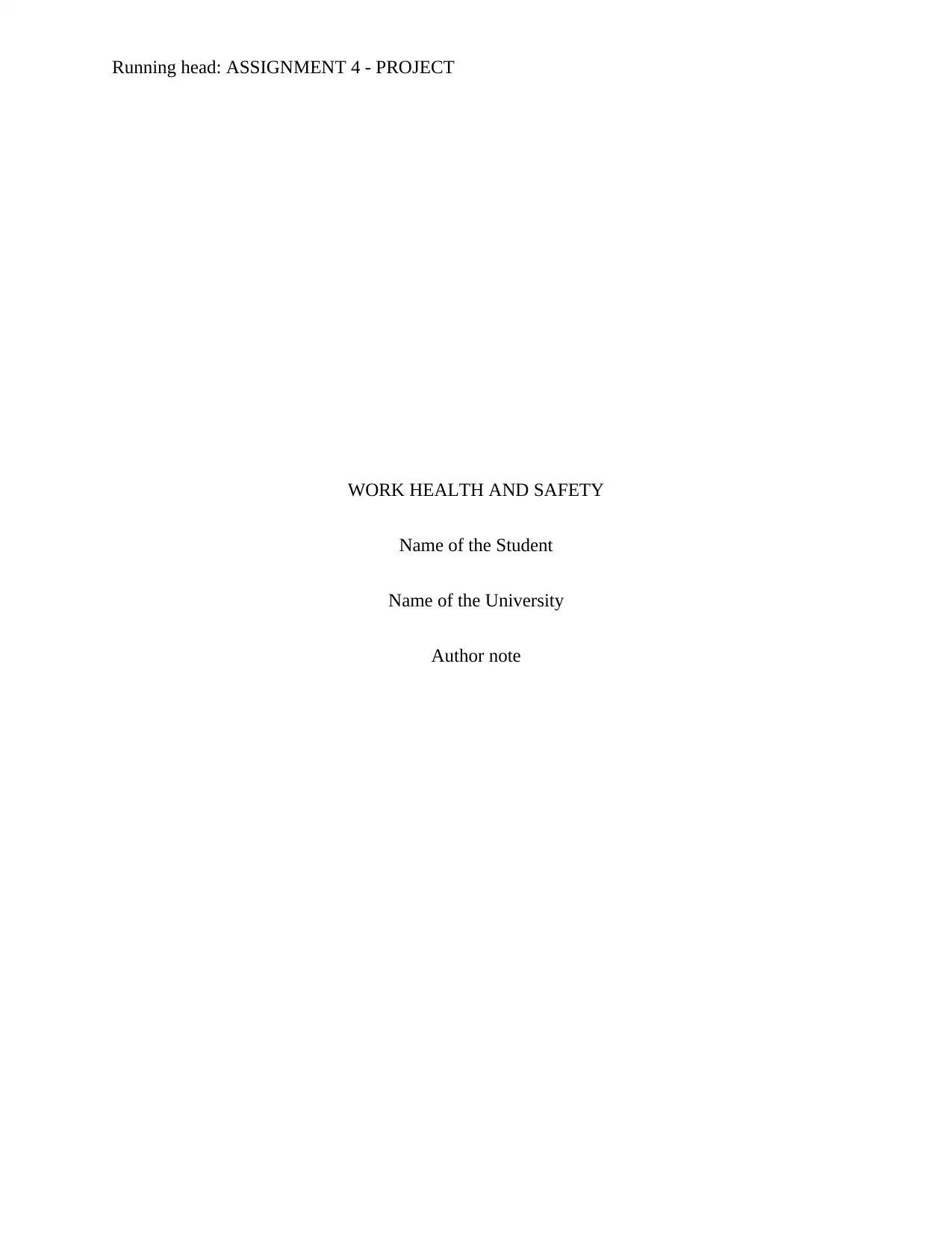
Running head: ASSIGNMENT 4 - PROJECT
WORK HEALTH AND SAFETY
Name of the Student
Name of the University
Author note
WORK HEALTH AND SAFETY
Name of the Student
Name of the University
Author note
Secure Best Marks with AI Grader
Need help grading? Try our AI Grader for instant feedback on your assignments.
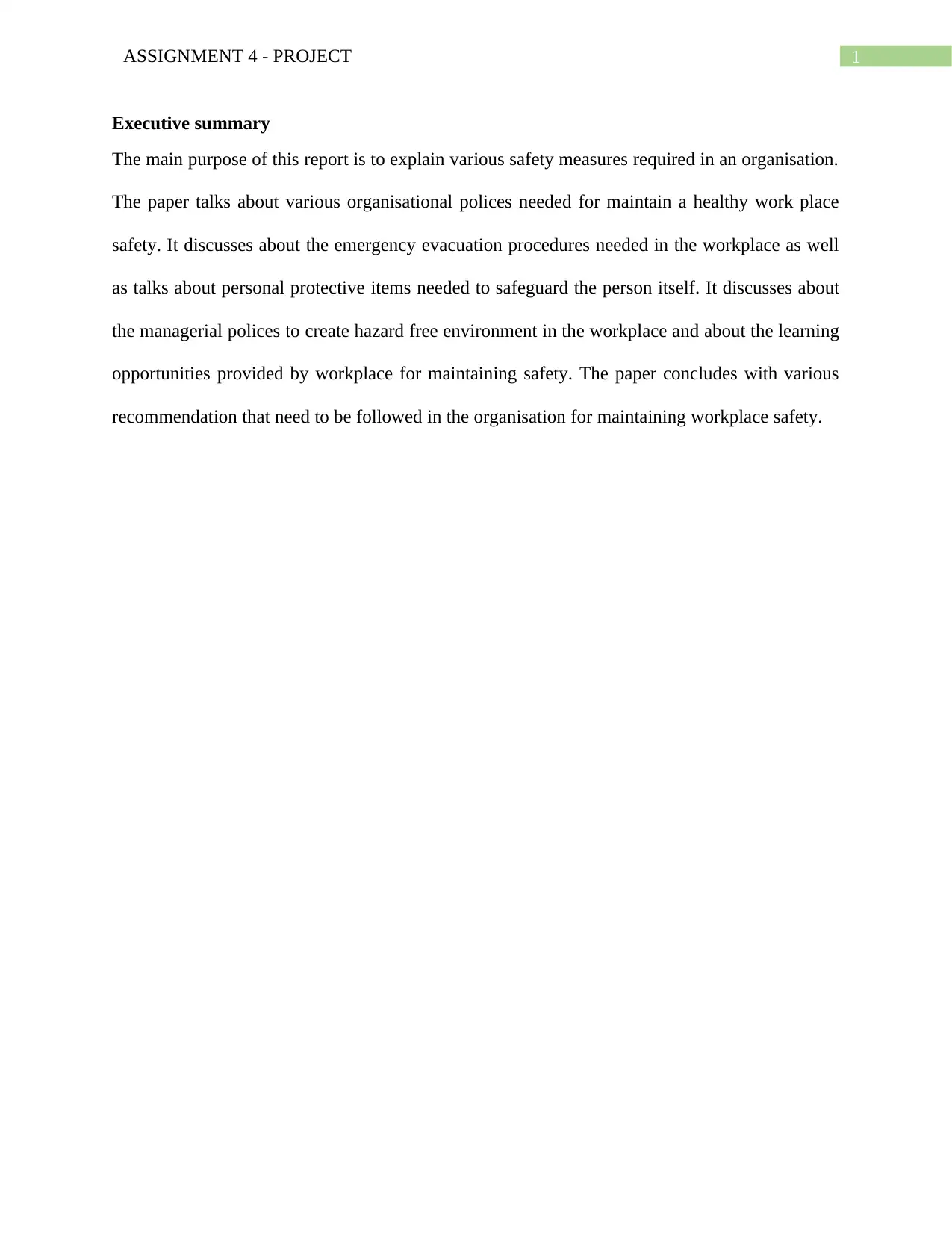
1ASSIGNMENT 4 - PROJECT
Executive summary
The main purpose of this report is to explain various safety measures required in an organisation.
The paper talks about various organisational polices needed for maintain a healthy work place
safety. It discusses about the emergency evacuation procedures needed in the workplace as well
as talks about personal protective items needed to safeguard the person itself. It discusses about
the managerial polices to create hazard free environment in the workplace and about the learning
opportunities provided by workplace for maintaining safety. The paper concludes with various
recommendation that need to be followed in the organisation for maintaining workplace safety.
Executive summary
The main purpose of this report is to explain various safety measures required in an organisation.
The paper talks about various organisational polices needed for maintain a healthy work place
safety. It discusses about the emergency evacuation procedures needed in the workplace as well
as talks about personal protective items needed to safeguard the person itself. It discusses about
the managerial polices to create hazard free environment in the workplace and about the learning
opportunities provided by workplace for maintaining safety. The paper concludes with various
recommendation that need to be followed in the organisation for maintaining workplace safety.
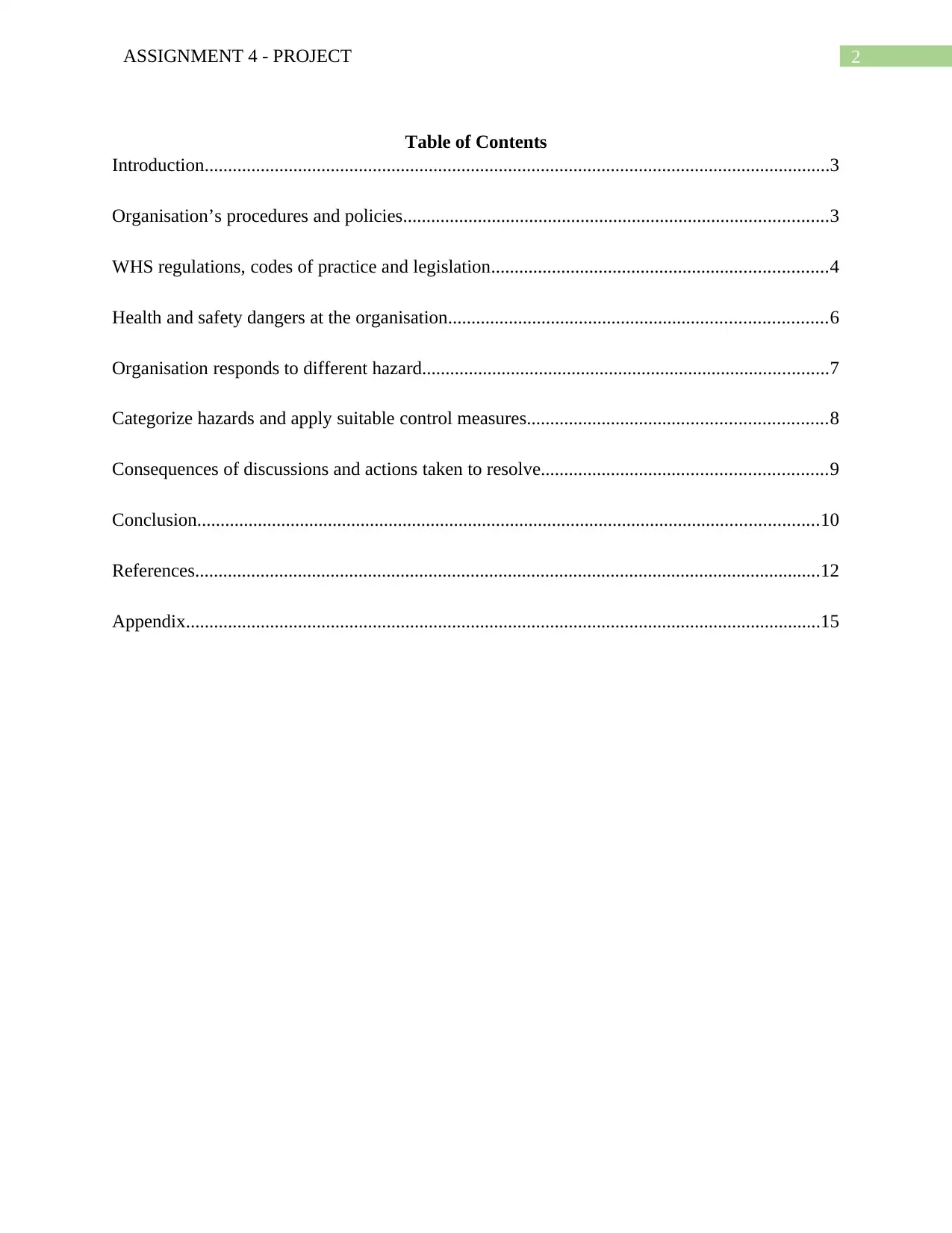
2ASSIGNMENT 4 - PROJECT
Table of Contents
Introduction......................................................................................................................................3
Organisation’s procedures and policies...........................................................................................3
WHS regulations, codes of practice and legislation........................................................................4
Health and safety dangers at the organisation.................................................................................6
Organisation responds to different hazard.......................................................................................7
Categorize hazards and apply suitable control measures................................................................8
Consequences of discussions and actions taken to resolve.............................................................9
Conclusion.....................................................................................................................................10
References......................................................................................................................................12
Appendix........................................................................................................................................15
Table of Contents
Introduction......................................................................................................................................3
Organisation’s procedures and policies...........................................................................................3
WHS regulations, codes of practice and legislation........................................................................4
Health and safety dangers at the organisation.................................................................................6
Organisation responds to different hazard.......................................................................................7
Categorize hazards and apply suitable control measures................................................................8
Consequences of discussions and actions taken to resolve.............................................................9
Conclusion.....................................................................................................................................10
References......................................................................................................................................12
Appendix........................................................................................................................................15
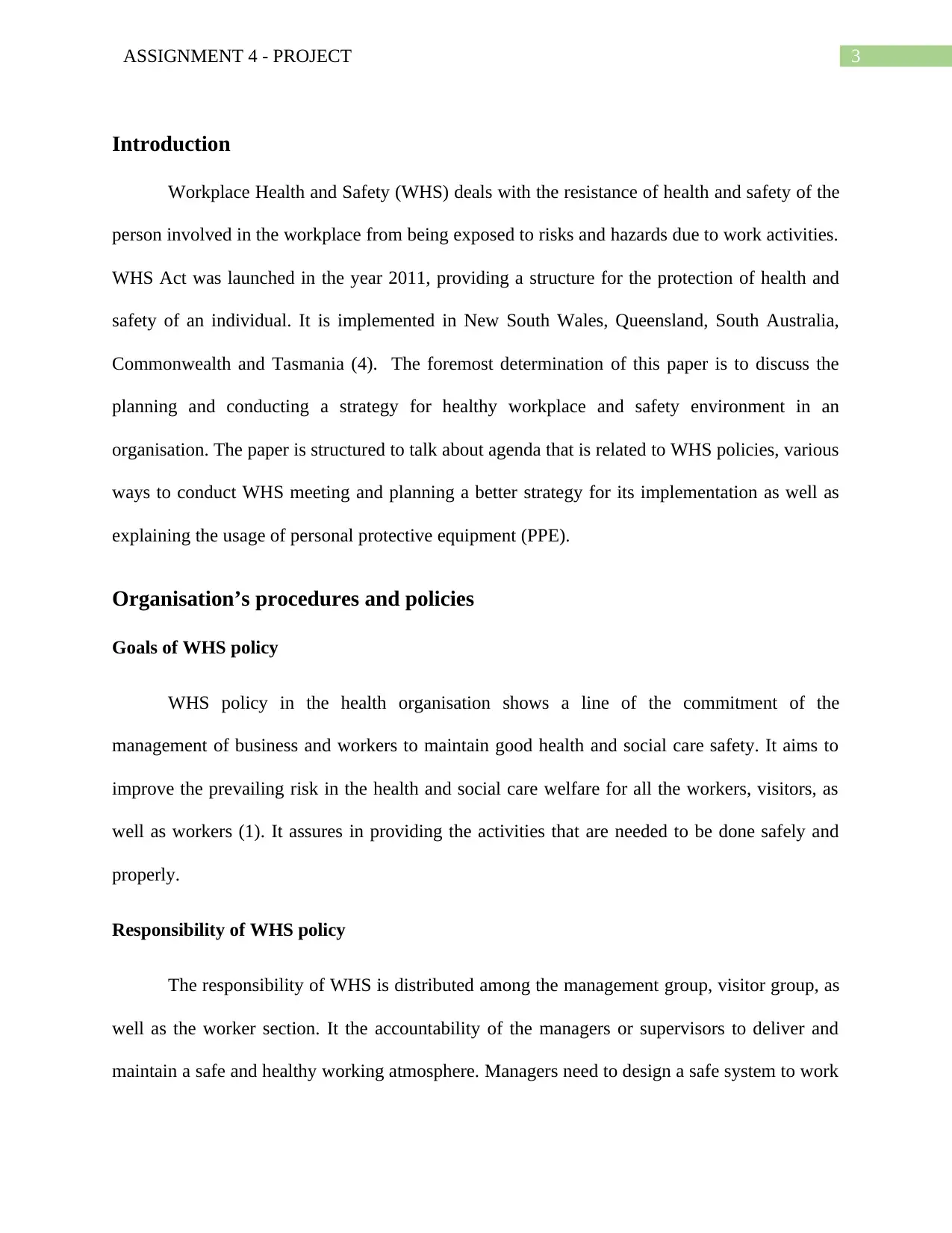
3ASSIGNMENT 4 - PROJECT
Introduction
Workplace Health and Safety (WHS) deals with the resistance of health and safety of the
person involved in the workplace from being exposed to risks and hazards due to work activities.
WHS Act was launched in the year 2011, providing a structure for the protection of health and
safety of an individual. It is implemented in New South Wales, Queensland, South Australia,
Commonwealth and Tasmania (4). The foremost determination of this paper is to discuss the
planning and conducting a strategy for healthy workplace and safety environment in an
organisation. The paper is structured to talk about agenda that is related to WHS policies, various
ways to conduct WHS meeting and planning a better strategy for its implementation as well as
explaining the usage of personal protective equipment (PPE).
Organisation’s procedures and policies
Goals of WHS policy
WHS policy in the health organisation shows a line of the commitment of the
management of business and workers to maintain good health and social care safety. It aims to
improve the prevailing risk in the health and social care welfare for all the workers, visitors, as
well as workers (1). It assures in providing the activities that are needed to be done safely and
properly.
Responsibility of WHS policy
The responsibility of WHS is distributed among the management group, visitor group, as
well as the worker section. It the accountability of the managers or supervisors to deliver and
maintain a safe and healthy working atmosphere. Managers need to design a safe system to work
Introduction
Workplace Health and Safety (WHS) deals with the resistance of health and safety of the
person involved in the workplace from being exposed to risks and hazards due to work activities.
WHS Act was launched in the year 2011, providing a structure for the protection of health and
safety of an individual. It is implemented in New South Wales, Queensland, South Australia,
Commonwealth and Tasmania (4). The foremost determination of this paper is to discuss the
planning and conducting a strategy for healthy workplace and safety environment in an
organisation. The paper is structured to talk about agenda that is related to WHS policies, various
ways to conduct WHS meeting and planning a better strategy for its implementation as well as
explaining the usage of personal protective equipment (PPE).
Organisation’s procedures and policies
Goals of WHS policy
WHS policy in the health organisation shows a line of the commitment of the
management of business and workers to maintain good health and social care safety. It aims to
improve the prevailing risk in the health and social care welfare for all the workers, visitors, as
well as workers (1). It assures in providing the activities that are needed to be done safely and
properly.
Responsibility of WHS policy
The responsibility of WHS is distributed among the management group, visitor group, as
well as the worker section. It the accountability of the managers or supervisors to deliver and
maintain a safe and healthy working atmosphere. Managers need to design a safe system to work
Secure Best Marks with AI Grader
Need help grading? Try our AI Grader for instant feedback on your assignments.
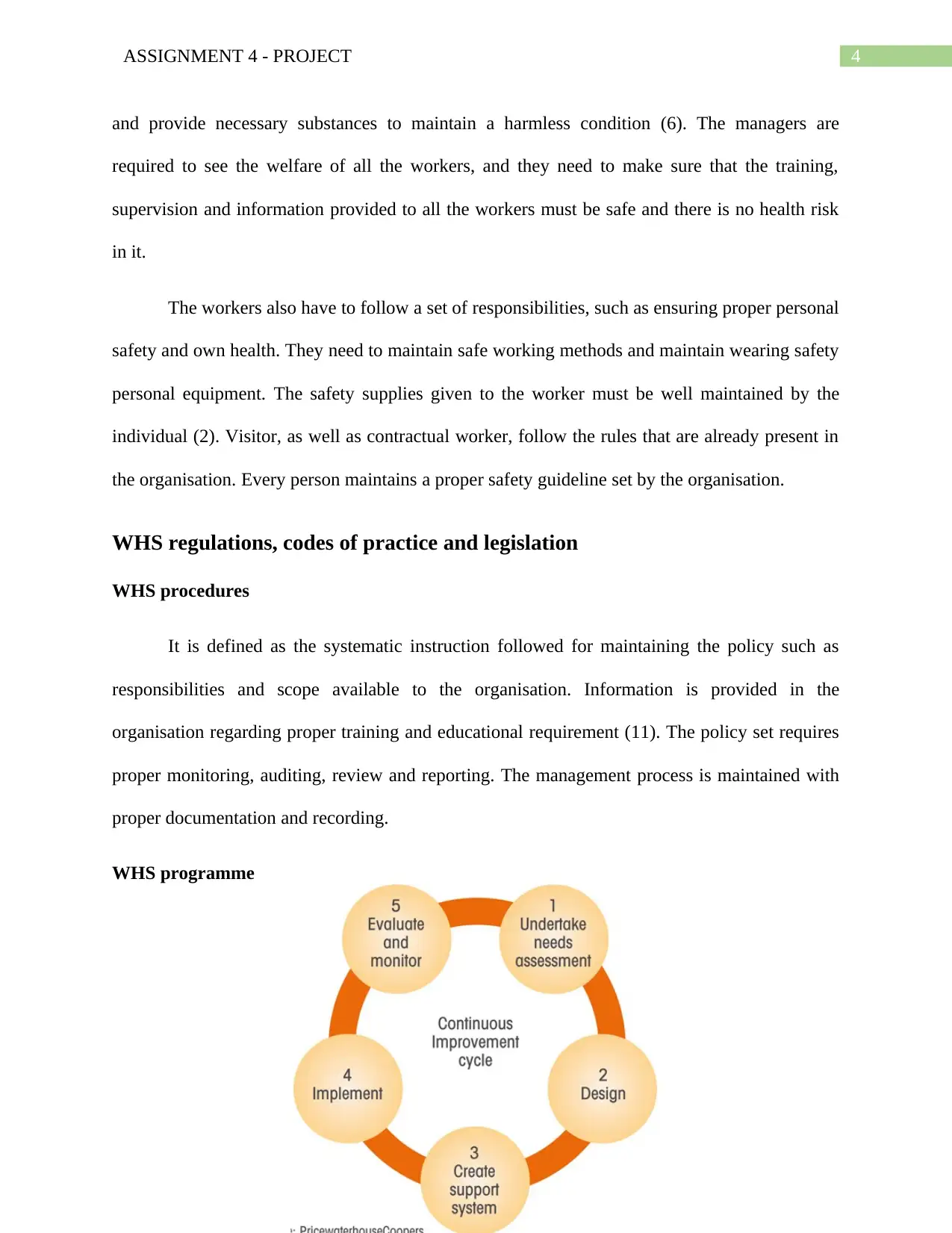
4ASSIGNMENT 4 - PROJECT
and provide necessary substances to maintain a harmless condition (6). The managers are
required to see the welfare of all the workers, and they need to make sure that the training,
supervision and information provided to all the workers must be safe and there is no health risk
in it.
The workers also have to follow a set of responsibilities, such as ensuring proper personal
safety and own health. They need to maintain safe working methods and maintain wearing safety
personal equipment. The safety supplies given to the worker must be well maintained by the
individual (2). Visitor, as well as contractual worker, follow the rules that are already present in
the organisation. Every person maintains a proper safety guideline set by the organisation.
WHS regulations, codes of practice and legislation
WHS procedures
It is defined as the systematic instruction followed for maintaining the policy such as
responsibilities and scope available to the organisation. Information is provided in the
organisation regarding proper training and educational requirement (11). The policy set requires
proper monitoring, auditing, review and reporting. The management process is maintained with
proper documentation and recording.
WHS programme
and provide necessary substances to maintain a harmless condition (6). The managers are
required to see the welfare of all the workers, and they need to make sure that the training,
supervision and information provided to all the workers must be safe and there is no health risk
in it.
The workers also have to follow a set of responsibilities, such as ensuring proper personal
safety and own health. They need to maintain safe working methods and maintain wearing safety
personal equipment. The safety supplies given to the worker must be well maintained by the
individual (2). Visitor, as well as contractual worker, follow the rules that are already present in
the organisation. Every person maintains a proper safety guideline set by the organisation.
WHS regulations, codes of practice and legislation
WHS procedures
It is defined as the systematic instruction followed for maintaining the policy such as
responsibilities and scope available to the organisation. Information is provided in the
organisation regarding proper training and educational requirement (11). The policy set requires
proper monitoring, auditing, review and reporting. The management process is maintained with
proper documentation and recording.
WHS programme
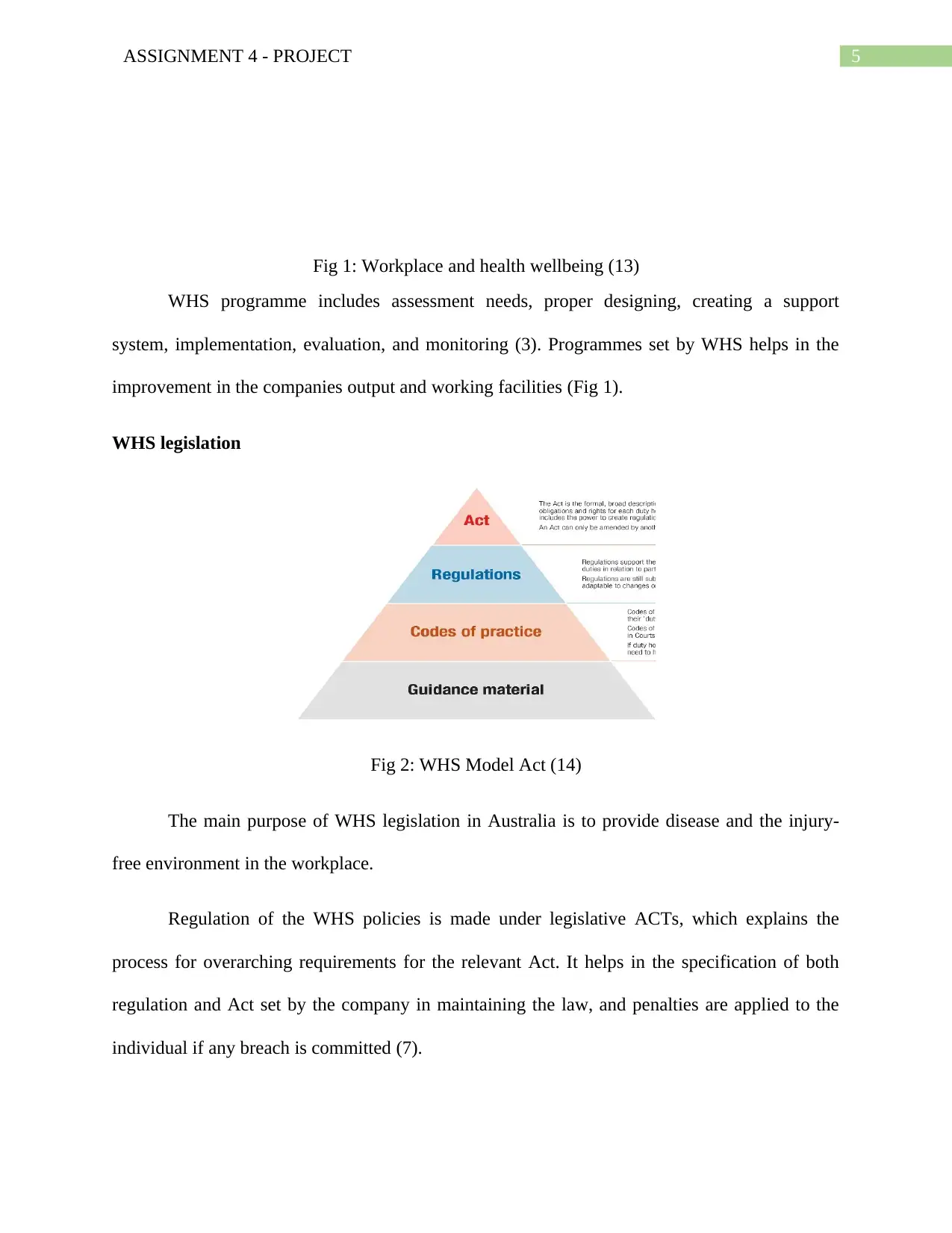
5ASSIGNMENT 4 - PROJECT
Fig 1: Workplace and health wellbeing (13)
WHS programme includes assessment needs, proper designing, creating a support
system, implementation, evaluation, and monitoring (3). Programmes set by WHS helps in the
improvement in the companies output and working facilities (Fig 1).
WHS legislation
Fig 2: WHS Model Act (14)
The main purpose of WHS legislation in Australia is to provide disease and the injury-
free environment in the workplace.
Regulation of the WHS policies is made under legislative ACTs, which explains the
process for overarching requirements for the relevant Act. It helps in the specification of both
regulation and Act set by the company in maintaining the law, and penalties are applied to the
individual if any breach is committed (7).
Fig 1: Workplace and health wellbeing (13)
WHS programme includes assessment needs, proper designing, creating a support
system, implementation, evaluation, and monitoring (3). Programmes set by WHS helps in the
improvement in the companies output and working facilities (Fig 1).
WHS legislation
Fig 2: WHS Model Act (14)
The main purpose of WHS legislation in Australia is to provide disease and the injury-
free environment in the workplace.
Regulation of the WHS policies is made under legislative ACTs, which explains the
process for overarching requirements for the relevant Act. It helps in the specification of both
regulation and Act set by the company in maintaining the law, and penalties are applied to the
individual if any breach is committed (7).
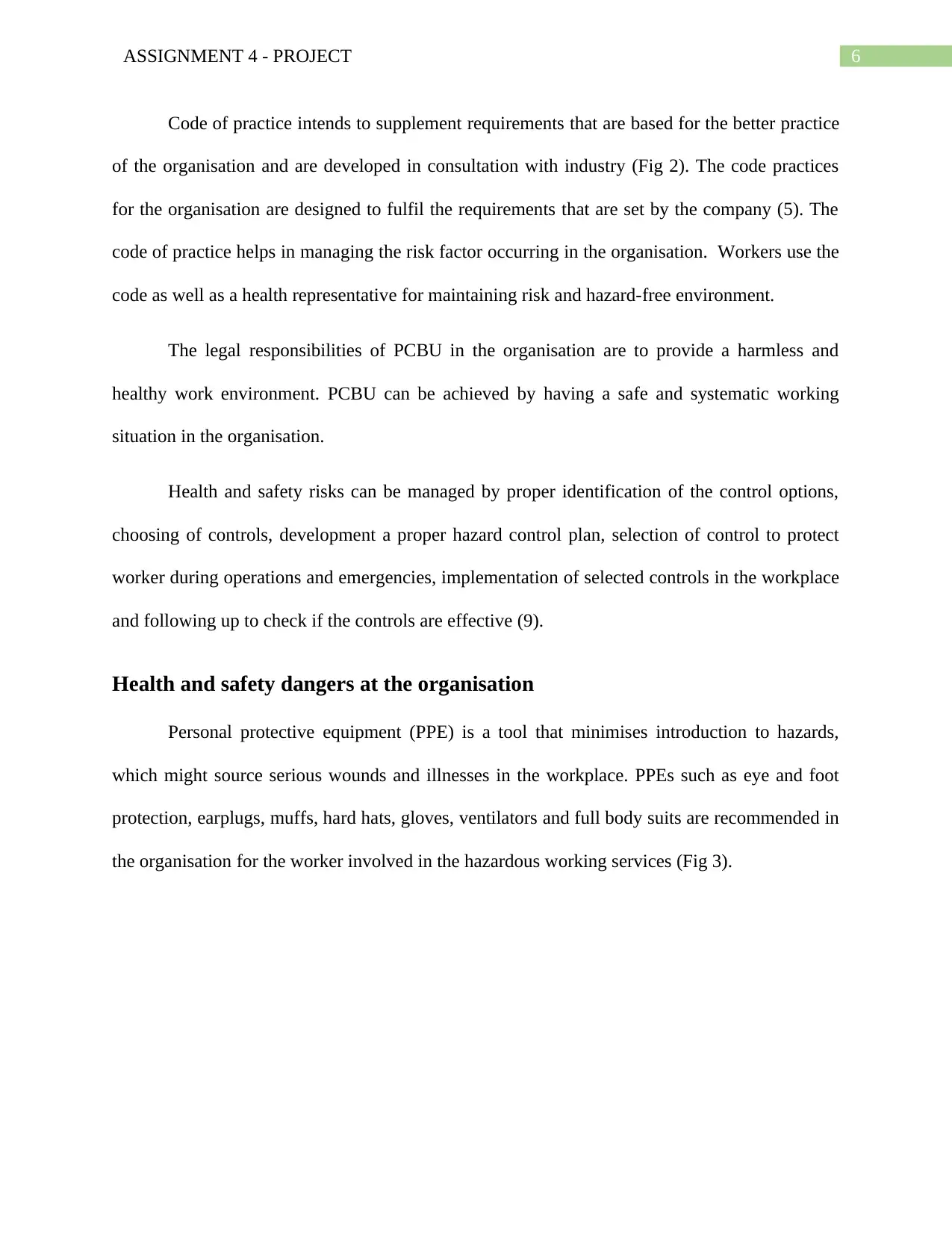
6ASSIGNMENT 4 - PROJECT
Code of practice intends to supplement requirements that are based for the better practice
of the organisation and are developed in consultation with industry (Fig 2). The code practices
for the organisation are designed to fulfil the requirements that are set by the company (5). The
code of practice helps in managing the risk factor occurring in the organisation. Workers use the
code as well as a health representative for maintaining risk and hazard-free environment.
The legal responsibilities of PCBU in the organisation are to provide a harmless and
healthy work environment. PCBU can be achieved by having a safe and systematic working
situation in the organisation.
Health and safety risks can be managed by proper identification of the control options,
choosing of controls, development a proper hazard control plan, selection of control to protect
worker during operations and emergencies, implementation of selected controls in the workplace
and following up to check if the controls are effective (9).
Health and safety dangers at the organisation
Personal protective equipment (PPE) is a tool that minimises introduction to hazards,
which might source serious wounds and illnesses in the workplace. PPEs such as eye and foot
protection, earplugs, muffs, hard hats, gloves, ventilators and full body suits are recommended in
the organisation for the worker involved in the hazardous working services (Fig 3).
Code of practice intends to supplement requirements that are based for the better practice
of the organisation and are developed in consultation with industry (Fig 2). The code practices
for the organisation are designed to fulfil the requirements that are set by the company (5). The
code of practice helps in managing the risk factor occurring in the organisation. Workers use the
code as well as a health representative for maintaining risk and hazard-free environment.
The legal responsibilities of PCBU in the organisation are to provide a harmless and
healthy work environment. PCBU can be achieved by having a safe and systematic working
situation in the organisation.
Health and safety risks can be managed by proper identification of the control options,
choosing of controls, development a proper hazard control plan, selection of control to protect
worker during operations and emergencies, implementation of selected controls in the workplace
and following up to check if the controls are effective (9).
Health and safety dangers at the organisation
Personal protective equipment (PPE) is a tool that minimises introduction to hazards,
which might source serious wounds and illnesses in the workplace. PPEs such as eye and foot
protection, earplugs, muffs, hard hats, gloves, ventilators and full body suits are recommended in
the organisation for the worker involved in the hazardous working services (Fig 3).
Paraphrase This Document
Need a fresh take? Get an instant paraphrase of this document with our AI Paraphraser
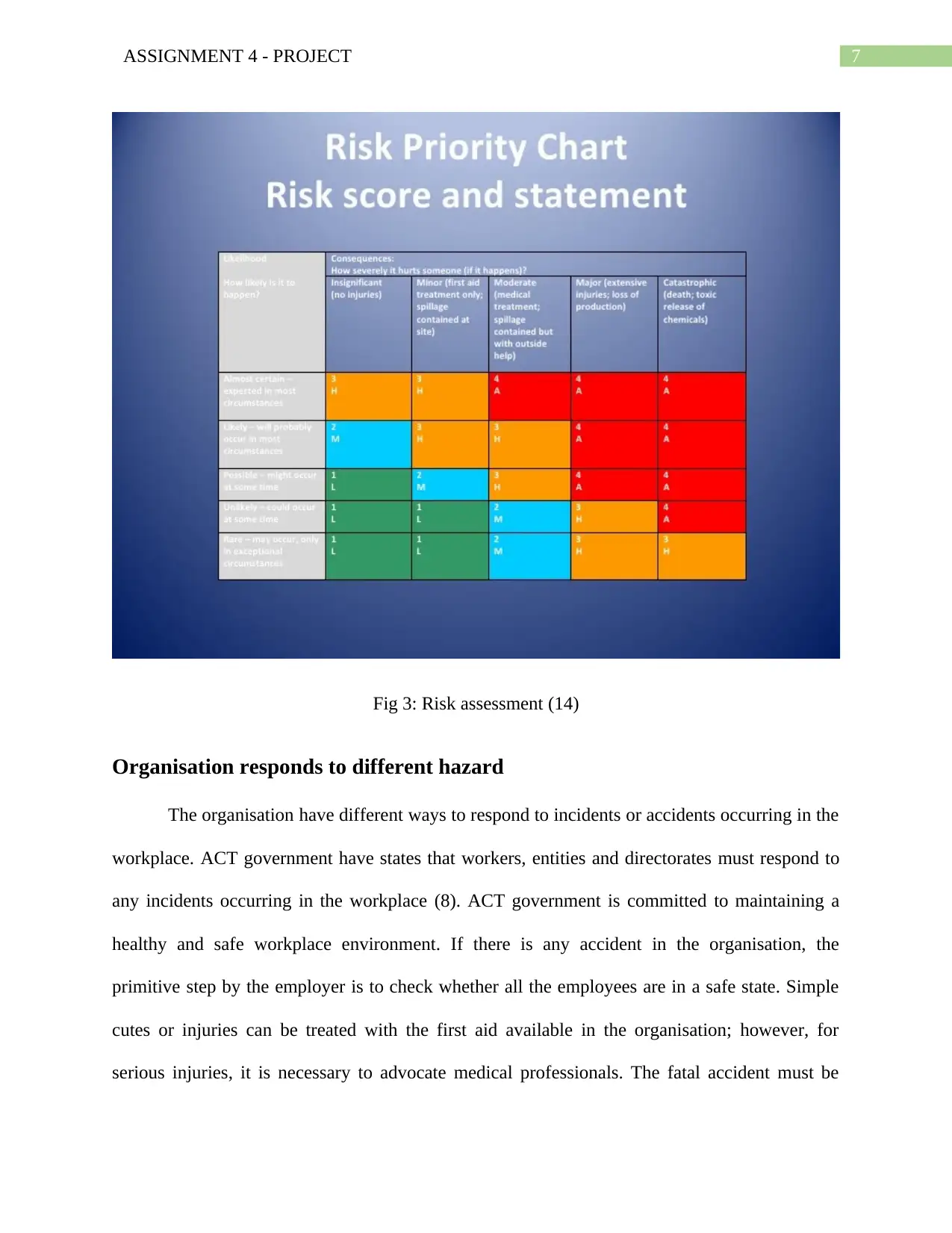
7ASSIGNMENT 4 - PROJECT
Fig 3: Risk assessment (14)
Organisation responds to different hazard
The organisation have different ways to respond to incidents or accidents occurring in the
workplace. ACT government have states that workers, entities and directorates must respond to
any incidents occurring in the workplace (8). ACT government is committed to maintaining a
healthy and safe workplace environment. If there is any accident in the organisation, the
primitive step by the employer is to check whether all the employees are in a safe state. Simple
cutes or injuries can be treated with the first aid available in the organisation; however, for
serious injuries, it is necessary to advocate medical professionals. The fatal accident must be
Fig 3: Risk assessment (14)
Organisation responds to different hazard
The organisation have different ways to respond to incidents or accidents occurring in the
workplace. ACT government have states that workers, entities and directorates must respond to
any incidents occurring in the workplace (8). ACT government is committed to maintaining a
healthy and safe workplace environment. If there is any accident in the organisation, the
primitive step by the employer is to check whether all the employees are in a safe state. Simple
cutes or injuries can be treated with the first aid available in the organisation; however, for
serious injuries, it is necessary to advocate medical professionals. The fatal accident must be
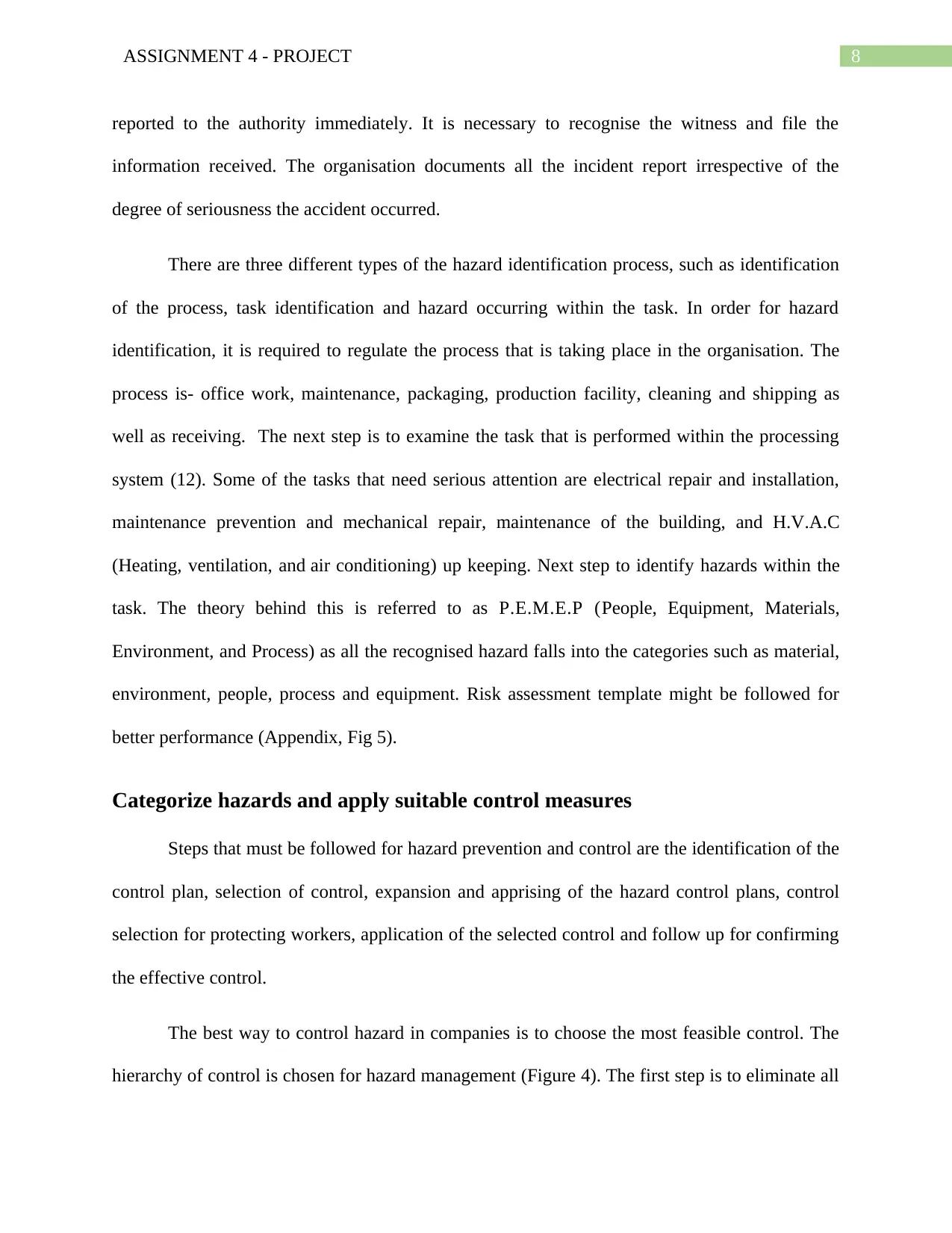
8ASSIGNMENT 4 - PROJECT
reported to the authority immediately. It is necessary to recognise the witness and file the
information received. The organisation documents all the incident report irrespective of the
degree of seriousness the accident occurred.
There are three different types of the hazard identification process, such as identification
of the process, task identification and hazard occurring within the task. In order for hazard
identification, it is required to regulate the process that is taking place in the organisation. The
process is- office work, maintenance, packaging, production facility, cleaning and shipping as
well as receiving. The next step is to examine the task that is performed within the processing
system (12). Some of the tasks that need serious attention are electrical repair and installation,
maintenance prevention and mechanical repair, maintenance of the building, and H.V.A.C
(Heating, ventilation, and air conditioning) up keeping. Next step to identify hazards within the
task. The theory behind this is referred to as P.E.M.E.P (People, Equipment, Materials,
Environment, and Process) as all the recognised hazard falls into the categories such as material,
environment, people, process and equipment. Risk assessment template might be followed for
better performance (Appendix, Fig 5).
Categorize hazards and apply suitable control measures
Steps that must be followed for hazard prevention and control are the identification of the
control plan, selection of control, expansion and apprising of the hazard control plans, control
selection for protecting workers, application of the selected control and follow up for confirming
the effective control.
The best way to control hazard in companies is to choose the most feasible control. The
hierarchy of control is chosen for hazard management (Figure 4). The first step is to eliminate all
reported to the authority immediately. It is necessary to recognise the witness and file the
information received. The organisation documents all the incident report irrespective of the
degree of seriousness the accident occurred.
There are three different types of the hazard identification process, such as identification
of the process, task identification and hazard occurring within the task. In order for hazard
identification, it is required to regulate the process that is taking place in the organisation. The
process is- office work, maintenance, packaging, production facility, cleaning and shipping as
well as receiving. The next step is to examine the task that is performed within the processing
system (12). Some of the tasks that need serious attention are electrical repair and installation,
maintenance prevention and mechanical repair, maintenance of the building, and H.V.A.C
(Heating, ventilation, and air conditioning) up keeping. Next step to identify hazards within the
task. The theory behind this is referred to as P.E.M.E.P (People, Equipment, Materials,
Environment, and Process) as all the recognised hazard falls into the categories such as material,
environment, people, process and equipment. Risk assessment template might be followed for
better performance (Appendix, Fig 5).
Categorize hazards and apply suitable control measures
Steps that must be followed for hazard prevention and control are the identification of the
control plan, selection of control, expansion and apprising of the hazard control plans, control
selection for protecting workers, application of the selected control and follow up for confirming
the effective control.
The best way to control hazard in companies is to choose the most feasible control. The
hierarchy of control is chosen for hazard management (Figure 4). The first step is to eliminate all
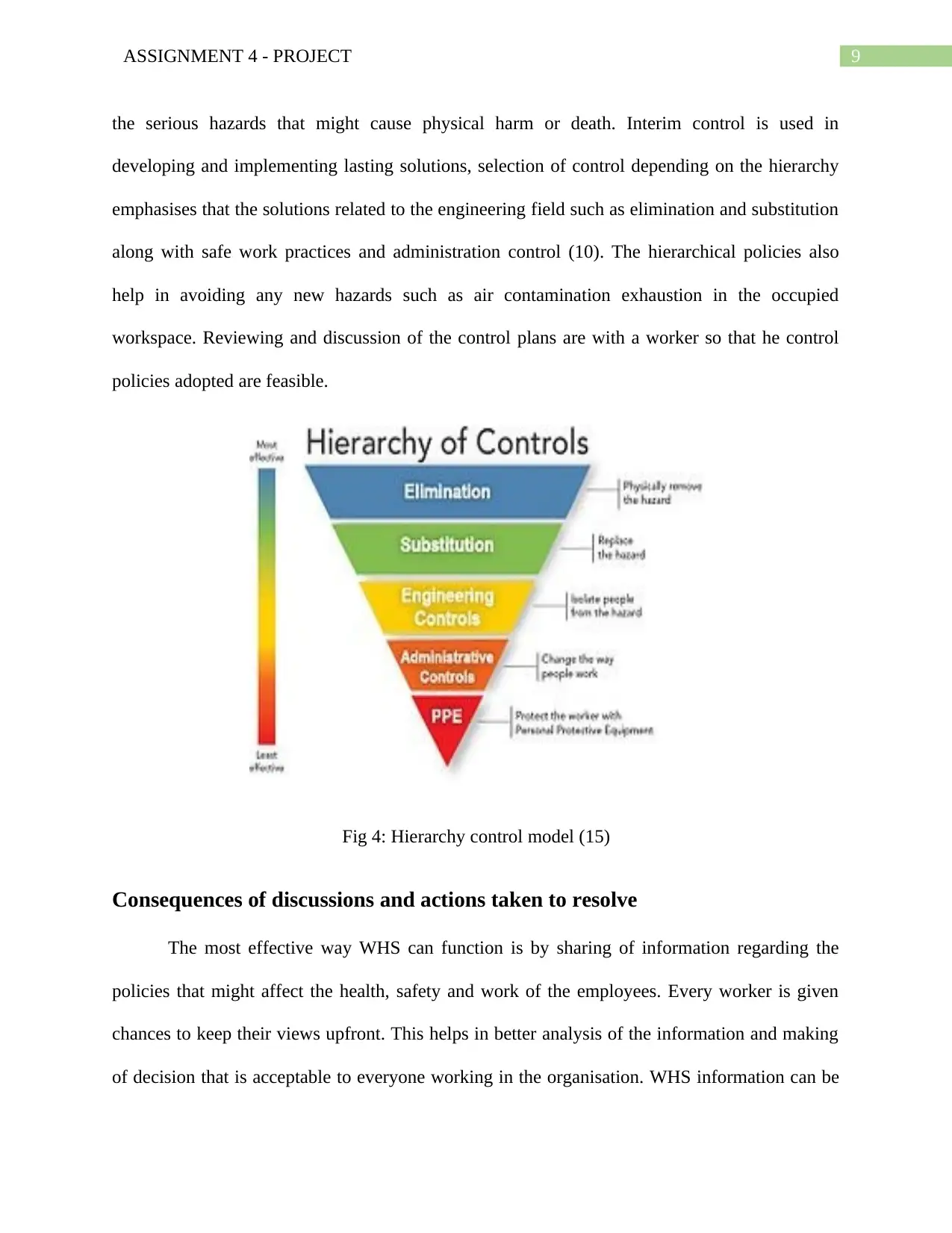
9ASSIGNMENT 4 - PROJECT
the serious hazards that might cause physical harm or death. Interim control is used in
developing and implementing lasting solutions, selection of control depending on the hierarchy
emphasises that the solutions related to the engineering field such as elimination and substitution
along with safe work practices and administration control (10). The hierarchical policies also
help in avoiding any new hazards such as air contamination exhaustion in the occupied
workspace. Reviewing and discussion of the control plans are with a worker so that he control
policies adopted are feasible.
Fig 4: Hierarchy control model (15)
Consequences of discussions and actions taken to resolve
The most effective way WHS can function is by sharing of information regarding the
policies that might affect the health, safety and work of the employees. Every worker is given
chances to keep their views upfront. This helps in better analysis of the information and making
of decision that is acceptable to everyone working in the organisation. WHS information can be
the serious hazards that might cause physical harm or death. Interim control is used in
developing and implementing lasting solutions, selection of control depending on the hierarchy
emphasises that the solutions related to the engineering field such as elimination and substitution
along with safe work practices and administration control (10). The hierarchical policies also
help in avoiding any new hazards such as air contamination exhaustion in the occupied
workspace. Reviewing and discussion of the control plans are with a worker so that he control
policies adopted are feasible.
Fig 4: Hierarchy control model (15)
Consequences of discussions and actions taken to resolve
The most effective way WHS can function is by sharing of information regarding the
policies that might affect the health, safety and work of the employees. Every worker is given
chances to keep their views upfront. This helps in better analysis of the information and making
of decision that is acceptable to everyone working in the organisation. WHS information can be
Secure Best Marks with AI Grader
Need help grading? Try our AI Grader for instant feedback on your assignments.
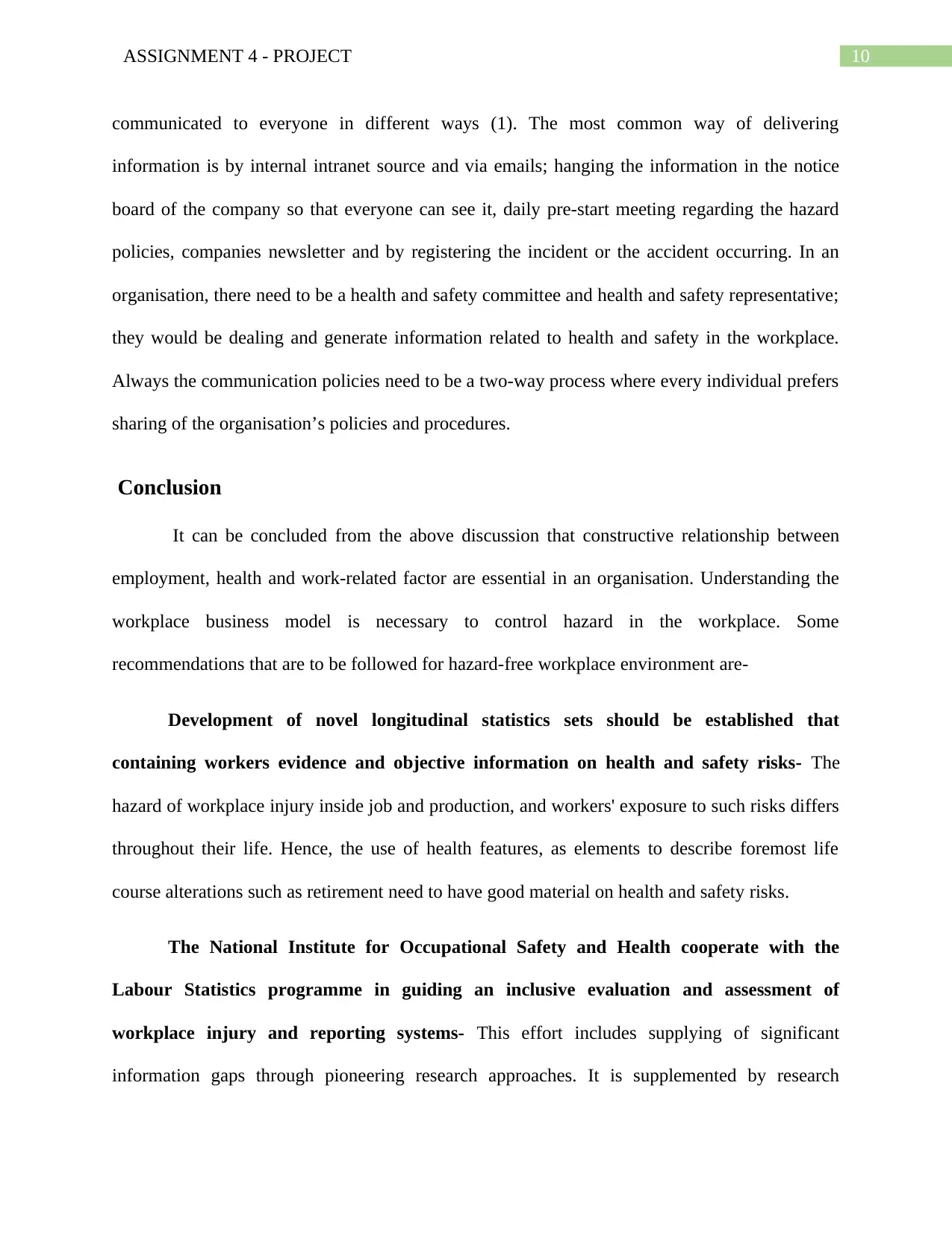
10ASSIGNMENT 4 - PROJECT
communicated to everyone in different ways (1). The most common way of delivering
information is by internal intranet source and via emails; hanging the information in the notice
board of the company so that everyone can see it, daily pre-start meeting regarding the hazard
policies, companies newsletter and by registering the incident or the accident occurring. In an
organisation, there need to be a health and safety committee and health and safety representative;
they would be dealing and generate information related to health and safety in the workplace.
Always the communication policies need to be a two-way process where every individual prefers
sharing of the organisation’s policies and procedures.
Conclusion
It can be concluded from the above discussion that constructive relationship between
employment, health and work-related factor are essential in an organisation. Understanding the
workplace business model is necessary to control hazard in the workplace. Some
recommendations that are to be followed for hazard-free workplace environment are-
Development of novel longitudinal statistics sets should be established that
containing workers evidence and objective information on health and safety risks- The
hazard of workplace injury inside job and production, and workers' exposure to such risks differs
throughout their life. Hence, the use of health features, as elements to describe foremost life
course alterations such as retirement need to have good material on health and safety risks.
The National Institute for Occupational Safety and Health cooperate with the
Labour Statistics programme in guiding an inclusive evaluation and assessment of
workplace injury and reporting systems- This effort includes supplying of significant
information gaps through pioneering research approaches. It is supplemented by research
communicated to everyone in different ways (1). The most common way of delivering
information is by internal intranet source and via emails; hanging the information in the notice
board of the company so that everyone can see it, daily pre-start meeting regarding the hazard
policies, companies newsletter and by registering the incident or the accident occurring. In an
organisation, there need to be a health and safety committee and health and safety representative;
they would be dealing and generate information related to health and safety in the workplace.
Always the communication policies need to be a two-way process where every individual prefers
sharing of the organisation’s policies and procedures.
Conclusion
It can be concluded from the above discussion that constructive relationship between
employment, health and work-related factor are essential in an organisation. Understanding the
workplace business model is necessary to control hazard in the workplace. Some
recommendations that are to be followed for hazard-free workplace environment are-
Development of novel longitudinal statistics sets should be established that
containing workers evidence and objective information on health and safety risks- The
hazard of workplace injury inside job and production, and workers' exposure to such risks differs
throughout their life. Hence, the use of health features, as elements to describe foremost life
course alterations such as retirement need to have good material on health and safety risks.
The National Institute for Occupational Safety and Health cooperate with the
Labour Statistics programme in guiding an inclusive evaluation and assessment of
workplace injury and reporting systems- This effort includes supplying of significant
information gaps through pioneering research approaches. It is supplemented by research
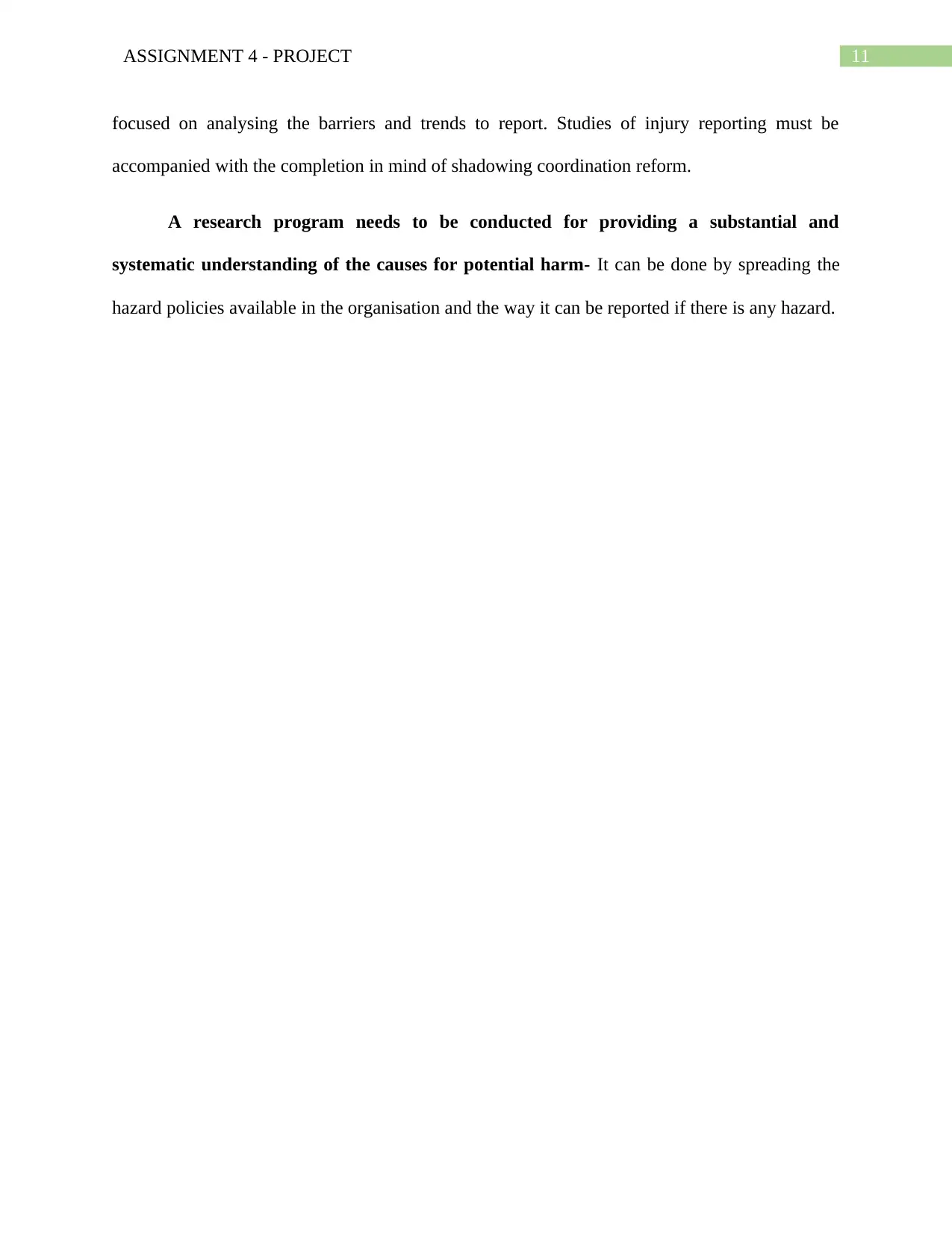
11ASSIGNMENT 4 - PROJECT
focused on analysing the barriers and trends to report. Studies of injury reporting must be
accompanied with the completion in mind of shadowing coordination reform.
A research program needs to be conducted for providing a substantial and
systematic understanding of the causes for potential harm- It can be done by spreading the
hazard policies available in the organisation and the way it can be reported if there is any hazard.
focused on analysing the barriers and trends to report. Studies of injury reporting must be
accompanied with the completion in mind of shadowing coordination reform.
A research program needs to be conducted for providing a substantial and
systematic understanding of the causes for potential harm- It can be done by spreading the
hazard policies available in the organisation and the way it can be reported if there is any hazard.
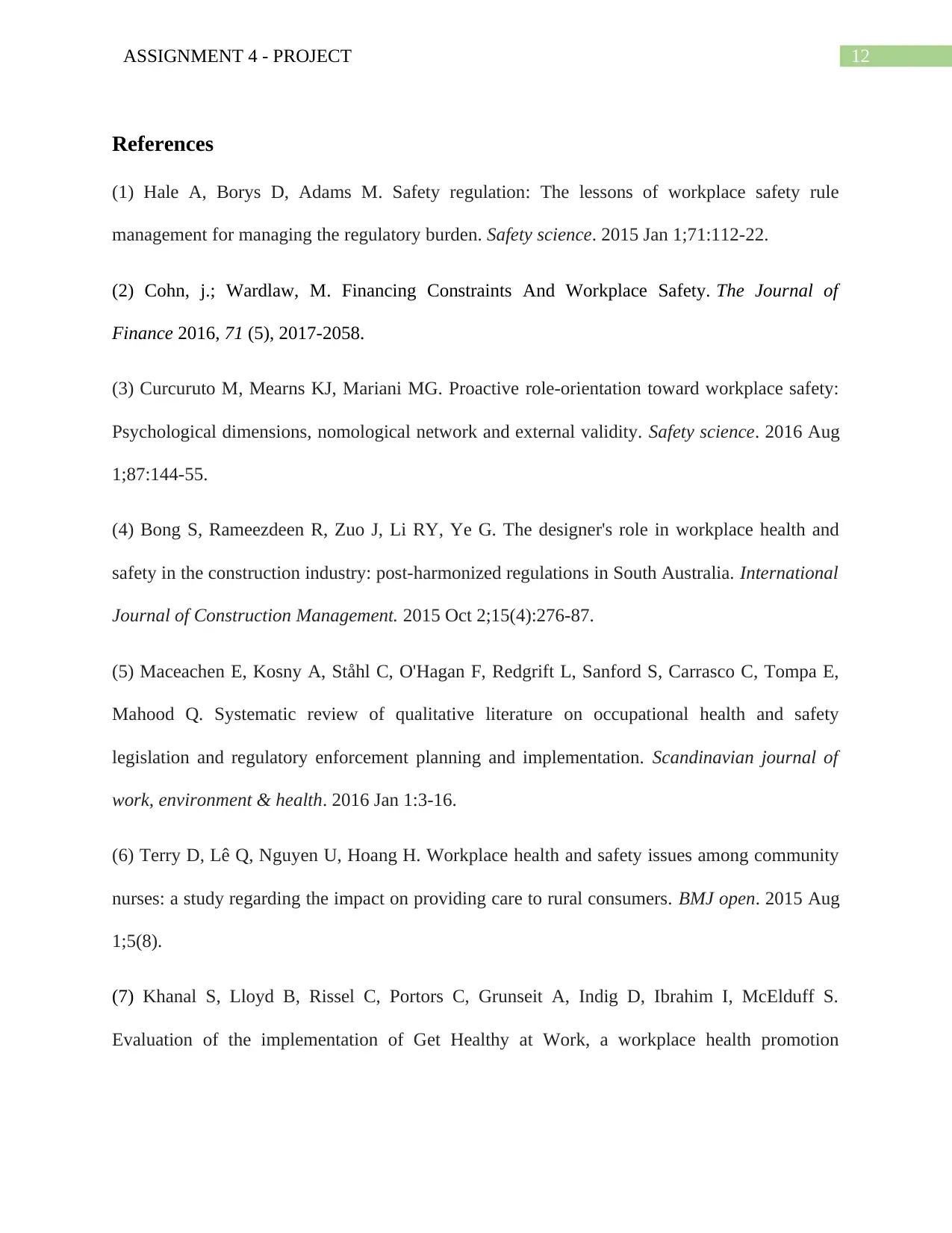
12ASSIGNMENT 4 - PROJECT
References
(1) Hale A, Borys D, Adams M. Safety regulation: The lessons of workplace safety rule
management for managing the regulatory burden. Safety science. 2015 Jan 1;71:112-22.
(2) Cohn, j.; Wardlaw, M. Financing Constraints And Workplace Safety. The Journal of
Finance 2016, 71 (5), 2017-2058.
(3) Curcuruto M, Mearns KJ, Mariani MG. Proactive role-orientation toward workplace safety:
Psychological dimensions, nomological network and external validity. Safety science. 2016 Aug
1;87:144-55.
(4) Bong S, Rameezdeen R, Zuo J, Li RY, Ye G. The designer's role in workplace health and
safety in the construction industry: post-harmonized regulations in South Australia. International
Journal of Construction Management. 2015 Oct 2;15(4):276-87.
(5) Maceachen E, Kosny A, Ståhl C, O'Hagan F, Redgrift L, Sanford S, Carrasco C, Tompa E,
Mahood Q. Systematic review of qualitative literature on occupational health and safety
legislation and regulatory enforcement planning and implementation. Scandinavian journal of
work, environment & health. 2016 Jan 1:3-16.
(6) Terry D, Lê Q, Nguyen U, Hoang H. Workplace health and safety issues among community
nurses: a study regarding the impact on providing care to rural consumers. BMJ open. 2015 Aug
1;5(8).
(7) Khanal S, Lloyd B, Rissel C, Portors C, Grunseit A, Indig D, Ibrahim I, McElduff S.
Evaluation of the implementation of Get Healthy at Work, a workplace health promotion
References
(1) Hale A, Borys D, Adams M. Safety regulation: The lessons of workplace safety rule
management for managing the regulatory burden. Safety science. 2015 Jan 1;71:112-22.
(2) Cohn, j.; Wardlaw, M. Financing Constraints And Workplace Safety. The Journal of
Finance 2016, 71 (5), 2017-2058.
(3) Curcuruto M, Mearns KJ, Mariani MG. Proactive role-orientation toward workplace safety:
Psychological dimensions, nomological network and external validity. Safety science. 2016 Aug
1;87:144-55.
(4) Bong S, Rameezdeen R, Zuo J, Li RY, Ye G. The designer's role in workplace health and
safety in the construction industry: post-harmonized regulations in South Australia. International
Journal of Construction Management. 2015 Oct 2;15(4):276-87.
(5) Maceachen E, Kosny A, Ståhl C, O'Hagan F, Redgrift L, Sanford S, Carrasco C, Tompa E,
Mahood Q. Systematic review of qualitative literature on occupational health and safety
legislation and regulatory enforcement planning and implementation. Scandinavian journal of
work, environment & health. 2016 Jan 1:3-16.
(6) Terry D, Lê Q, Nguyen U, Hoang H. Workplace health and safety issues among community
nurses: a study regarding the impact on providing care to rural consumers. BMJ open. 2015 Aug
1;5(8).
(7) Khanal S, Lloyd B, Rissel C, Portors C, Grunseit A, Indig D, Ibrahim I, McElduff S.
Evaluation of the implementation of Get Healthy at Work, a workplace health promotion
Paraphrase This Document
Need a fresh take? Get an instant paraphrase of this document with our AI Paraphraser
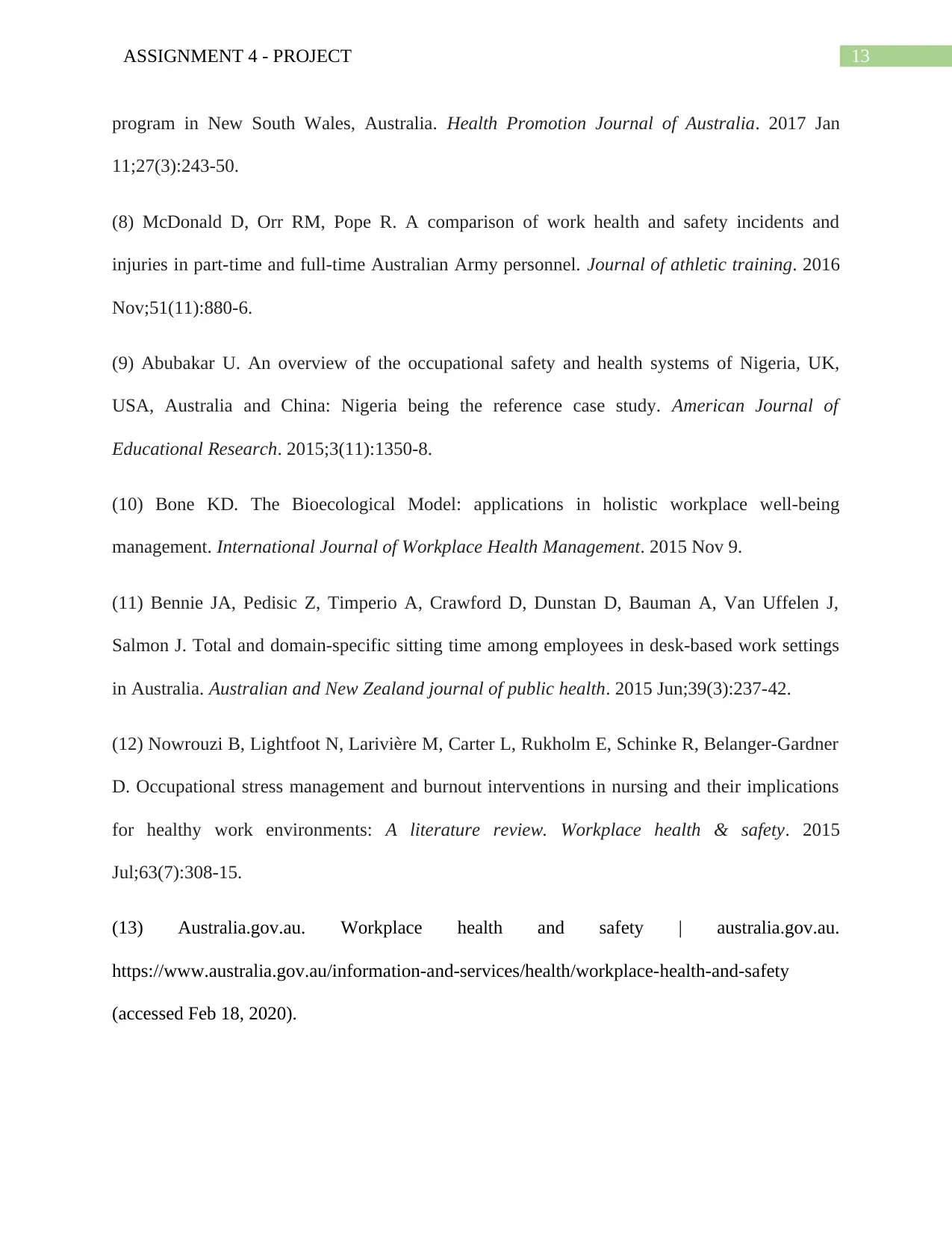
13ASSIGNMENT 4 - PROJECT
program in New South Wales, Australia. Health Promotion Journal of Australia. 2017 Jan
11;27(3):243-50.
(8) McDonald D, Orr RM, Pope R. A comparison of work health and safety incidents and
injuries in part-time and full-time Australian Army personnel. Journal of athletic training. 2016
Nov;51(11):880-6.
(9) Abubakar U. An overview of the occupational safety and health systems of Nigeria, UK,
USA, Australia and China: Nigeria being the reference case study. American Journal of
Educational Research. 2015;3(11):1350-8.
(10) Bone KD. The Bioecological Model: applications in holistic workplace well-being
management. International Journal of Workplace Health Management. 2015 Nov 9.
(11) Bennie JA, Pedisic Z, Timperio A, Crawford D, Dunstan D, Bauman A, Van Uffelen J,
Salmon J. Total and domain‐specific sitting time among employees in desk‐based work settings
in Australia. Australian and New Zealand journal of public health. 2015 Jun;39(3):237-42.
(12) Nowrouzi B, Lightfoot N, Larivière M, Carter L, Rukholm E, Schinke R, Belanger-Gardner
D. Occupational stress management and burnout interventions in nursing and their implications
for healthy work environments: A literature review. Workplace health & safety. 2015
Jul;63(7):308-15.
(13) Australia.gov.au. Workplace health and safety | australia.gov.au.
https://www.australia.gov.au/information-and-services/health/workplace-health-and-safety
(accessed Feb 18, 2020).
program in New South Wales, Australia. Health Promotion Journal of Australia. 2017 Jan
11;27(3):243-50.
(8) McDonald D, Orr RM, Pope R. A comparison of work health and safety incidents and
injuries in part-time and full-time Australian Army personnel. Journal of athletic training. 2016
Nov;51(11):880-6.
(9) Abubakar U. An overview of the occupational safety and health systems of Nigeria, UK,
USA, Australia and China: Nigeria being the reference case study. American Journal of
Educational Research. 2015;3(11):1350-8.
(10) Bone KD. The Bioecological Model: applications in holistic workplace well-being
management. International Journal of Workplace Health Management. 2015 Nov 9.
(11) Bennie JA, Pedisic Z, Timperio A, Crawford D, Dunstan D, Bauman A, Van Uffelen J,
Salmon J. Total and domain‐specific sitting time among employees in desk‐based work settings
in Australia. Australian and New Zealand journal of public health. 2015 Jun;39(3):237-42.
(12) Nowrouzi B, Lightfoot N, Larivière M, Carter L, Rukholm E, Schinke R, Belanger-Gardner
D. Occupational stress management and burnout interventions in nursing and their implications
for healthy work environments: A literature review. Workplace health & safety. 2015
Jul;63(7):308-15.
(13) Australia.gov.au. Workplace health and safety | australia.gov.au.
https://www.australia.gov.au/information-and-services/health/workplace-health-and-safety
(accessed Feb 18, 2020).
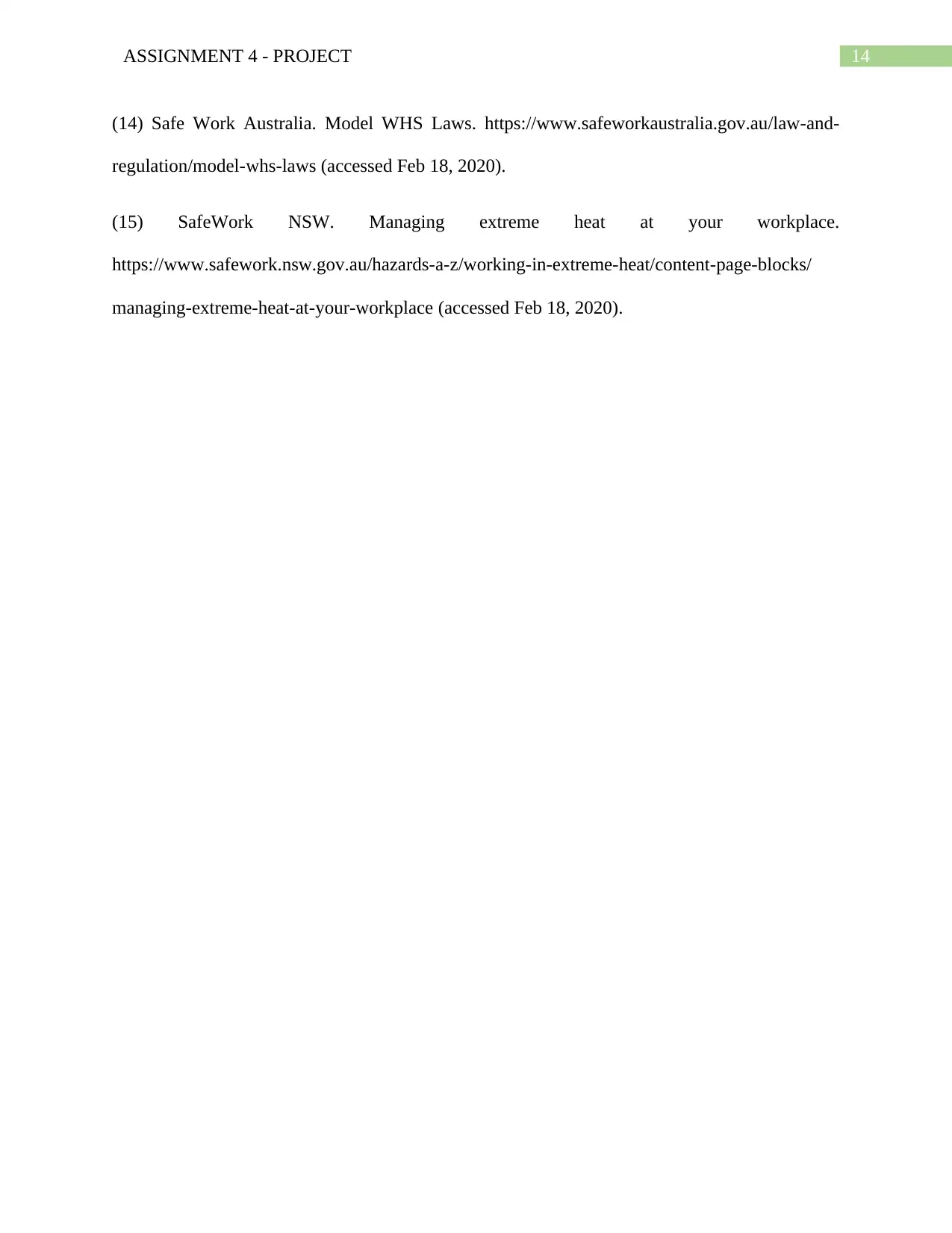
14ASSIGNMENT 4 - PROJECT
(14) Safe Work Australia. Model WHS Laws. https://www.safeworkaustralia.gov.au/law-and-
regulation/model-whs-laws (accessed Feb 18, 2020).
(15) SafeWork NSW. Managing extreme heat at your workplace.
https://www.safework.nsw.gov.au/hazards-a-z/working-in-extreme-heat/content-page-blocks/
managing-extreme-heat-at-your-workplace (accessed Feb 18, 2020).
(14) Safe Work Australia. Model WHS Laws. https://www.safeworkaustralia.gov.au/law-and-
regulation/model-whs-laws (accessed Feb 18, 2020).
(15) SafeWork NSW. Managing extreme heat at your workplace.
https://www.safework.nsw.gov.au/hazards-a-z/working-in-extreme-heat/content-page-blocks/
managing-extreme-heat-at-your-workplace (accessed Feb 18, 2020).
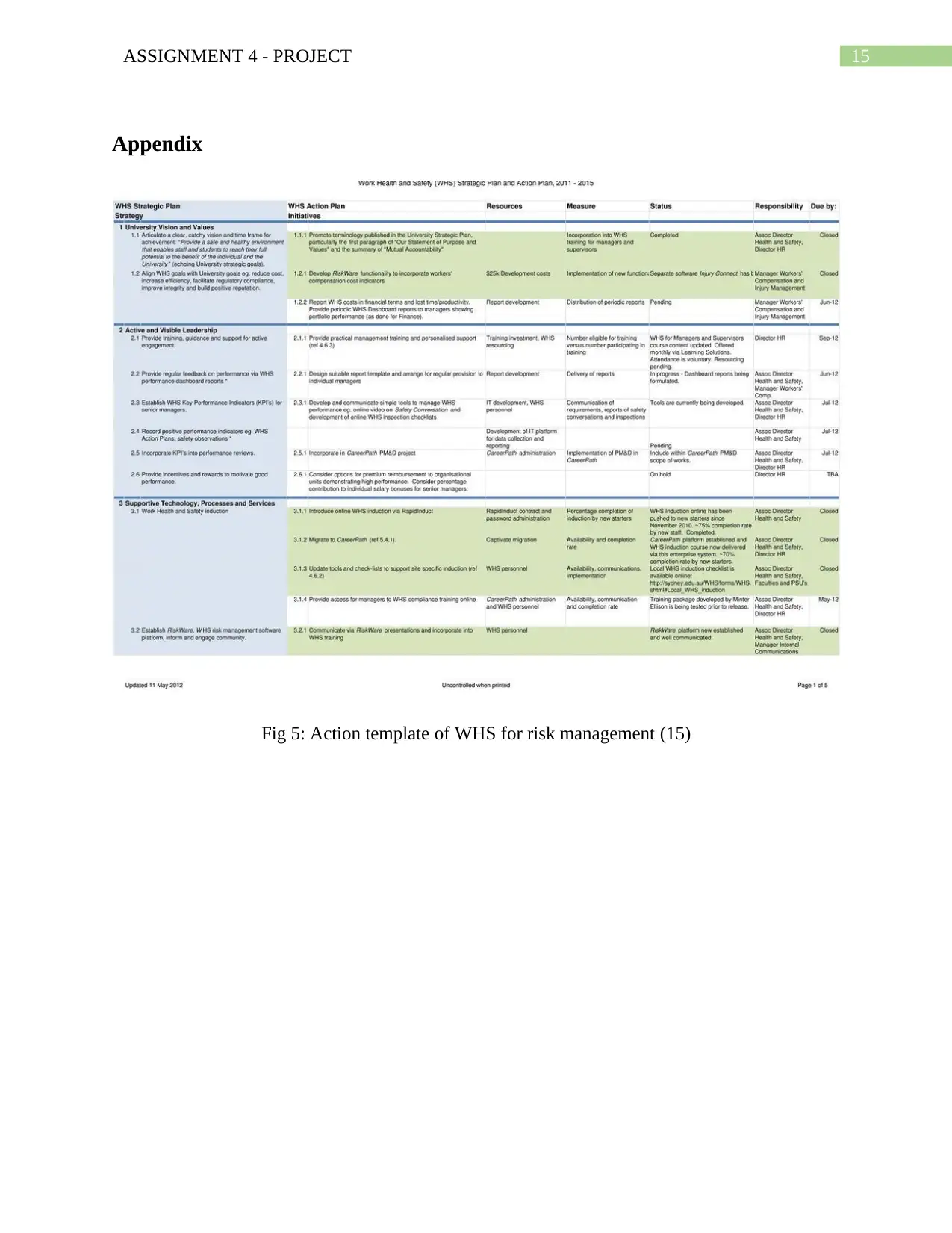
15ASSIGNMENT 4 - PROJECT
Appendix
Fig 5: Action template of WHS for risk management (15)
Appendix
Fig 5: Action template of WHS for risk management (15)
1 out of 16
Related Documents
Your All-in-One AI-Powered Toolkit for Academic Success.
+13062052269
info@desklib.com
Available 24*7 on WhatsApp / Email
![[object Object]](/_next/static/media/star-bottom.7253800d.svg)
Unlock your academic potential
© 2024 | Zucol Services PVT LTD | All rights reserved.





